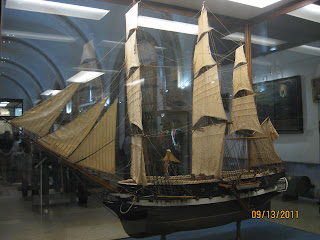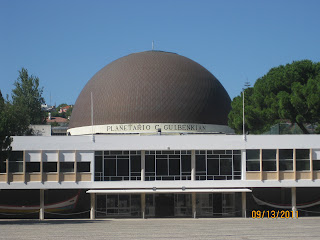The National Museum of Ancient Art (O Museu Nacional de Arte Antiga) was the best museum that I have been to yet in Portugal. The museum is inside of a 17th century palace that was acquired by the famous Marques de Pombal in 1770. The actual museum and its artifacts, paintings, and statues were all magnificent. There was a lot of art from many European countries, a few oriental countries, and a large section devoted specifically to Portuguese art. My favorite paintings were those of the Savior, I loved looking at them and seeing the emotion and detail put into them. I was also intrigued by a ceramic violin found in the ceramics collection, which was made for the royal family in the 1800's. My favorite statue was of Mary with Christ in her arm's after He had been crucified. I thoroughly enjoyed my visit to this massive museum.
Wednesday, September 28, 2011
Carcavelos Beach
I went with a few of my friends from the dorms that I live in to a beach nearby a few weekends ago. It was a beautiful beach and we had a lot of fun. At the end of the beach there is a big castle/fortress. I'm not exactly sure what it was used for, but from afar it looked like an enormous sand castle. It took about a half hour by train to get to the beach, and we had a fun, sunny day. I'm glad that I have made some friends to hang out with while I am here, everyone is very nice.
Aqueduto das Aquas Livres (Aqueduct of the Free Waters)
One of the more impressive architectural feats that I have seen so far in Europe was this ancient aqueduct. It was constructed by Joao V in 1748, though it was not fully completed for another hundred years or so. It provided water for many parts of Portugal that did not have fresh water sources at the time. In total it is about 36 miles long and at its tallest height is 213 feet. Legend has it that in the 1800's a robber would steal from those crossing the aqueduct and then throw them off of the bridge. You are still able to cross the aqueduct today, but we got there after it had already closed. I will definitely go back later to cross it. Once again, it is amazing to think how incredible of a structure was built hundreds of years ago, and how good of shape it is still in today. I also went back later with Camilia to see it and to go across it, but unfortunately by the date we got there it had already closed down for the winter, I guess I just didn't have much luck in the crossing of this thing, but it was still pretty to look at.
Parque Eduardo VII
This is the largest of the parks in the central part of Lisbon, and it was named after Kind Edward VII. He was actually the king of England, who came to Portugal in 1902 to reaffirm the alliance between England and Portugal. There is a huge, long, grassy area that goes uphill from a round-about/city square called Praca Marques de Pombal at the bottom up to the monument at the top. The grassy hill is 62 acres in size, and the well trimmed bushes and hedging are artistically and beautifully placed. The monument at the top is yet another dedicated to April 25th when Portugal became democratic. It was fun hiking up to the top of the monument and looking down on the city, quite beautiful without a doubt.
Goodbye to the Gale's
It was really nice to see some familiar faces when I arrived in Lisbon. Elder and Sister Gale, from my home ward in Draper, were serving a mission here in Lisbon until they had to go home for medical reasons about a week ago. They were so nice to me and had me over for dinner and lunch a couple of times making me feel at home, and even gave Camilia's ring a safe home in their dresser before I brought it to London to give to her when I proposed. I was just as disappointed as they were that they had to leave, but I know the Lord has other things in store for them back home.
Miradouro de Sao Pedro de Alcantara-A Square and View Point
At the top of the Elevador da Gloria you get off at this city square/ park with a beautiful view of eastern Lisbon, the Castelo de Sao George across the way, as well as the Tejo River. There are benches to sit and look at the views and pretty trees, flowers and fountains as well. There is a memorial in the garden which is in memory of the founder of the first newspaper in Lisbon, the Diaro de Noticias. It was in this area that the newspaper industry used to be centered, before it was moved to a different more spacious part of Lisbon. I really enjoyed the pretty views of the city from up on the miradouro (viewpoint). Also pictured is one of the many artists in the streets of Lisbon who paint pictures of the city and its many cultural and beautiful sights.
Elevador da Gloria
They call this cable car an elevator because it takes you up one of the steepest, cobblestone streets in the city. It is bright yellow and it rattles up the hill for about 5 minutes to get to the top, where it stops at Bairro Alto and right next to the Miadouro de Sao Pedro de Alcantara (see next post to see this!). It was fun taking the little car up the hill, a very touristy thing to do but fun nonetheless. There are locals that do use it though to get up the hill, especially the elderly. It is considered a form of public transportation because you can use your metro/bus card to take it up for free. I also went up it with Cam and her friends when they came here.
Museu de Marinha (Maritime Museum)
This was a museum that I know John would have loved, I will have to take him there someday for sure. This museum is on the west wing of the monastery that I visited earlier. The chapel behind me was built by Henry the Navigator, (who launched the age of discoveries) and it was here that the sailors and discoverers would go to mass before they would go on their adventures and voyages. It was interesting to see the progression and advancements made in the sailing world throughout the centuries, from the boats themselves to the clothing used to the navigational instruments used to find their way. Statues and paintings of famous explorers such as Christopher Columbus, Magellan, Vasco da Gama, and Henry the Navigator were also on display. I enjoyed learning more and experiencing the rich history of the age of the discoveries in Portugal. It is said that the Portuguese mariners would leave Portugal as discoverers and return as heroes. It is incredible how much of the world the Portuguese discovered and claimed as their's, which is one reason why Portuguese is the sixth most spoken language in the world. Also shown is the Planetarium Calouste Gulbenkian, which is right next to the Maritime Museum.
Subscribe to:
Comments (Atom)























































